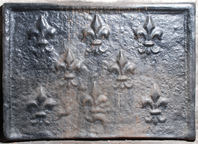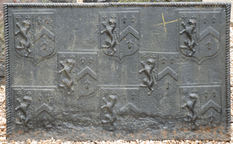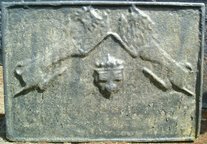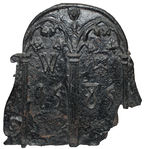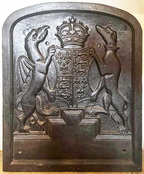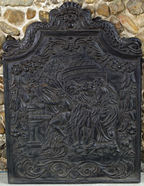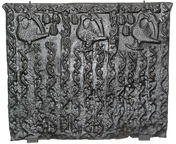-
90
Description: Rectangular; ovolo moulded edging (top and sides); eight impressions of a fleur de lys, arranged in three horizontal rows (3-2-3), carefully spaced.
Notes: The same fleur de lys stamp has been noted on several firebacks, indicating a common source.
Copies of this fireback are known.
- Decoration tags:
- rectangular (shape)
- ovolo (edging)
- carved stamps
- heraldic
- objects
Manufactured: in the mid- to late-16th century possibly at Pounsley Furnace, Framfield in the Weald area of England.
Current location: Hampton Court, Richmond, Greater London, England.
(part of the Royal Collection museum group)
- Attached to series:
- Pounsley series
- Fleur-de-lys firebacks
-
387
Description: Arched rectangular shape; astragal edging. Shield, helm, crest and mantling of the Worshipful Company of Blacksmiths.
Notes: Blazon: Sable, a chevron Or between three hammers Argent handled and crowned with open crowns of the second; Crest: a phoenix in flames rising proper; arms granted in 1611. Formerly part of the J. H. Every collection.
Copies of this fireback are known.
Arms: Worshipful Company of Blacksmiths
- Decoration tags:
- rectangular with round arch (shape)
- astragal (edging)
- whole carved pattern
- planklines
- armorial
Manufactured: in the mid-17th century in the Weald area of England.
Current location: Anne of Cleves House, Southover High Street, Lewes, East Sussex, England.
Museum number: 1944.24.052 (part of the Sussex Archaeological Society museum group)
- Attached to series:
- Livery company firebacks
-
480
Description: Arched rectangle; ovolo, egg-and-dart moulded edging; shield, helm, coronet, crest and mantling; curved inscription panel below shield.
Notes: The heraldic devices on the shield, and the form of the helm and crest suggest this may be a continental achievement of arms; the style of the fireback is, however, is more characteristic of English types.
Copies of this fireback are known.
Inscription: ... D HADRIANI ... EQVITE DOM DE HE.. / ... M.. ... ... [?]
Arms: not known
- Decoration tags:
- rectangular with round arch (shape)
- egg and dart (edging)
- whole carved pattern
- planklines
- armorial
- text
Manufactured: in the early-17th century .
Current location: Maidstone Museum, St Faith's Street, Maidstone, Kent, England.
(part of the Maidstone Museum museum group)
- Attached to series:
- Personal armorial firebacks
-
1141
Description: Arched rectangular shape; twisted rope edging (top and sides); date stamp, 1634, in arch; initials, EH, separated by a cross, below date.
Notes: The same date stamp has been noted on another fireback; the cross between the initials may have an apotropaic purpose.
Inscription: 1634 /E + H
- Decoration tags:
- rectangular with round arch (shape)
- rope (edging)
- simple stamps
- individual letters
- date stamp
- apotropaic
- text
- objects
Manufactured: in 1634 in England.
Current location: Newark Park, Ozleworth, Gloucestershire, England.
(part of the National Trust museum group)
- Attached to series:
- 1634 stamp series
-
607
Description: Rectangular; twisted rope edging (top and sides only); eight shields of Ayloffe impaling Sulyard in three rows, 3-2-3; Ayloffe: sable, a lion rampant Or, collared gules, between three crosses formy of the second; Sulyard: argent, a chevron gules between three pheons inverted sable.
Notes: William Ayloffe (c1535-1584) of Bretons, Hornchurch, Essex, Justice of the Court of Queen’s Bench, married (c1560) Jane, dau. of Sir Eustace Sulyard, of Runwell, Essex.
Arms: Ayloffe impaling Sulyard (William Ayloffe of Bretons, Hornchurch)
- Decoration tags:
- rectangular (shape)
- rope (edging)
- carved stamps
- armorial
Manufactured: in the early-17th century in the Weald area of England.
Current location: Mark Ripley Forge & Fireplaces, Northbridge Street, Robertsbridge, East Sussex, England.
- Attached to series:
- Ayloffe series
- Personal armorial firebacks
-
619
Description: Rectangular; astragal edging; leopard passant guardant sinister canted, facing a leopard passant, with a crowned shield between bearing the initials, KH, above a fleur-de-lys.
Notes: One of the Royal series with uncommonly few stamps.
Copies of this fireback are known.
Inscription: KH
- Decoration tags:
- rectangular (shape)
- astragal (edging)
- carved stamps
- heraldic
- animals
Manufactured: in the mid-16th century in the Weald area of England.
Current location: Mark Ripley Forge & Fireplaces, Northbridge Street, Robertsbridge, East Sussex, England.
- Attached to series:
- Royal series
-
694
Description: Arched shape with scrolled side brackets; astragal edging on arch; bipartite design with side pilasters and a central pilaster surmounted by two gothic traceried arches within each of which are two roses and two fleurs-de-lys; below left arch, letter ‘W’ (possibly ‘WY’ monogram) above first half of date; below right arch, shield bearing arms of the Borough of Stratford-upon-Avon above second half of date.
Notes: The combination of the monogram and the arms of Stratford suggest an individual with a formal office within the borough; a mixture of Gothic and Classical elements; damage to bottom right side.
Inscription: W [Y?] / 15 85
Arms: Borough of Stratford-upon-Avon
- Decoration tags:
- rounded arched (shape)
- astragal (edging)
- whole carved pattern
- individual letters
- individual numbers
- heraldic
- architectural
- text
Manufactured: in 1585 in England.
Current location: Nash's House, Chapel Street, Stratford-upon-Avon, Warwickshire, England.
(part of the Shakespeare's Birthplace Trust museum group)
- Attached to series:
- Miscellaneous pattern firebacks
- Civic firebacks
-
1286
Description: Low-arched shape within broad fillet edging; on a plain field a Tudor royal shield, quarterly France Modern and England, supported by a stylised dragon and greyhound and surmounted by a crown, all resting on a two-stepped compartment with cavetto- and astragal-moulded edging at the top.
Notes: Pastiche 'Tudor' design by George Shaw of Saddleworth, Lancashire, c.1850, possibly intended to be passed off as genuine Tudor. Another casting in this form is to be found in The Guildhall, Lichfield. More decorated examples exist, with a leaf pattern on the edging and 'scales' on the dragon. Firebacks of the same armorial design within a different, arched rectangular, edging are known.
Copies of this fireback are known.
Arms: Tudor royal
- Decoration tags:
- rounded arched (shape)
- fillet (edging)
- whole carved pattern
- heraldic
- armorial
- royal
Manufactured: in the mid-19th century possibly in the Lancashire area of England.
Current location: not known.
- Attached to series:
- George Shaw series
- Tudor royal armorial firebacks
-
716
Description: Cavetto canted rectangular central panel with ovolo-moulded edging, enclosing a pictorial scene of a naked female seated at a fountain on the left, with two clothed males to her right; behind, a part of a domed brick building with the inscription around the top of the wall; enclosing the scene, twin floral festoons suspended from top centre; on top, a central crown between two descending dolphins.
Notes: The scene depicts the Apocryphal story of Susanna and the Elders.
Copies of this fireback are known.
Inscription: SVSANA
- Decoration tags:
- 'Dutch' (shape)
- ovolo (edging)
- whole carved pattern
- pictorial
- biblical
- architectural
- humans
Manufactured: in the late-17th to early-18th century in Germany.
Current location: not known.
-
735
Description: Rectangular; three birds (probably swans, a Lancastrian badge) turned to the left, their heads facing right, and the front edge of their left wing extended and inverted; vine pattern strips, one horizontal along the top, and 14, of varied length, vertically across the rest of the fireback; seven ‘grape bunch’ shapes with criss-cross markings, arranged in three groups — 3-1-3 — adjacent to the birds.
Notes: The same vine strips are found on several firebacks, including some of the ‘Anne Forster’ series; the birds are also seen on a number of firebacks; the ‘grape bunch’ shapes may be the same as those on the ‘Anne Forster’ graveslab in Crowhurst church, Surrey. John Starkie Gardner and later writers attributed the birds to an association with the Fowle family; this is unlikely to be correct as the Fowles came to prominence in the iron industry towards the end of the sixteenth century and had their own distinctive decorative emblems. Formerly in the collection of Lady Dorothy Nevill.
- Decoration tags:
- rectangular (shape)
- complex, furniture-derived (edging)
- simple stamps
- carved stamps
- animals
- objects
Manufactured: in the mid- to late-16th century possibly at Pounsley Furnace, Framfield in the Weald area of England.
Current location: Victoria & Albert Museum, Cromwell Road, Kensington & Chelsea, Greater London, England.
Museum number: M.120-1914 (part of the Victoria & Albert Museum museum group)
Citation: Dawson, C., 1903, 'Sussex Iron Work and Pottery', Sussex Archaeological Collections, 46, pp. 1-54.
Citation: Gardner, J. S., 1898, 'Iron Casting in the Weald', Archaeologia, 56, 1, pp. 133-164.
Citation: Straker, E., 1931, Wealden Iron (London, Bell).
- Attached to series:
- Pounsley series
- Vine strip series
- Swan series
- Furniture stamp firebacks
